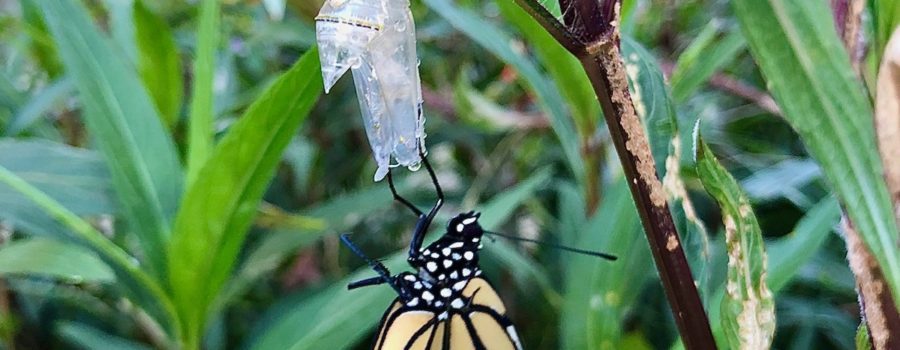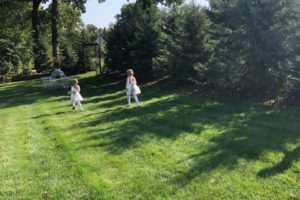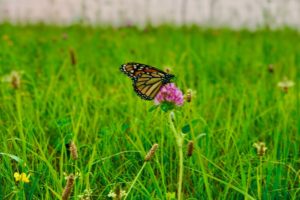We bought two milkweed plants a couple months ago after a neighbor showed me her caterpillar-covered milkweed.
Alice followed me as I carried the plants out of the car. “Where are you going to put them?” she asked, big blue eyes darting around the yard. I told her I planned to put them on the side of the house, because, to be honest, the milkWEED didn’t really fit in with the landscaping.
Alice had other plans though. She wanted them front and center, right next to our walkway. Though it didn’t help the decor, there are some times it isn’t worth arguing with Alice. In fact, it is almost never worth arguing with the dimpled-handed, wide-eyed, dictator.
She helped dig up the sandy soil and wrestle the weeds into their new home.
The leaves were covered in small dark dots. Eggs.
We checked the plants daily. I grew impatient as the black dots remained black dots. I began to wonder if they even were caterpillar eggs, or if the plants were just diseased.
But one morning, as I examined the plants, I noticed tiny holes covering the leaves. I flipped a leaf over, and sure enough, there was a teeny tiny caterpillar, munching her way through a leaf.

I was mesmerized. Alice and Avery were…. sort of intrigued?
Each morning, I dragged the girls outside to stare at the caterpillars. We watched as the tiny holes on the leaves turned into large holes. We watched as the caterpillars shed their skin and grew larger. We watched as entire leaves disappeared and as the caterpillars ate down the stems of the plant.

The plants disappeared as the caterpillars grew chunky, and I began to wonder when we would find a chrysalis.
Google told me that when a caterpillar is around 2 inches long, it turns into a chrysalis. So I measured them. They were easily two inches. I looked at them expectantly. I checked on them hourly, not wanting to miss the big transition.
But they didn’t. They ate, and they ate, and they ate. Again, I felt impatient. The same sort of impatience I felt when I was nine days overdue with Avery.
Nature really irks me sometimes, with its slow, never rushing progress.
I grew convinced that the lizards who live in our petunia plants must be eating the fat caterpillars, so I bought more milkweed plants and moved the remaining caterpillars to plants inside our screened-in lanai, away from the lizard population. I put them next to the glass sliding door in the kitchen, where we could watch them.
Finally, one day, I watched as a caterpillar hung herself upside down in the “J shape.” And I knew, it was about time.
I camped out in the kitchen, unsure of what I was looking for, but not wanting to miss the transformation of a chunky caterpillar into a green, gold-studded chrysalis.
Well, it turns out they hang in that J-shape for 12-24 hours, sometimes longer. So the next morning, as I darted to take a shower, it shed its final layer of skin.
And when I returned to the kitchen, it was in the final throes of scootching, bunching, and swinging itself into its beautiful green home for the next two weeks.
Again, the waiting games were on.
I examined the chrysalis multiple times each day, looking for a sign- any sign- that a butterfly might emerge. If I looked at the chrysalis from the right, sun-lit angle, I could see the wings, neatly folded up.
As the days passed, the chrysalis turned from bright green to a darker green, eventually becoming see-through right before the butterfly emerged.

And then one morning, right as the sun was rising under dark thunder clouds, I noticed that the shape of a chrysalis had changed. I went outside to investigate further, and watched, as a newly emerged butterfly hung, her wings still folded and crumpled.

Consistent with the great timing of nature, I had to go drop Avery off at school, so I couldn’t watch the transformation unfold.
When I returned, her wings had expanded to full size, wrinkle-free, and breath-taking. I brought her out of the screened-in enclosure, outside to the world. Her dainty legs clung to my finger.
She began to flap her wings, testing them out.
And then she flew. As if she had never, as Chad likes to put it, slimed around, eating leaves.
As I watched her fly away, I was reminded of a question Alice asked weeks earlier as we watched the caterpillars devour leaves. “Mom, does a caterpillar know it is going to turn into a butterfly?”
“I don’t know,” I had replied at the time. I was struck by her question. It was so deep, and simply worded something I often wondered about myself.
But now, after watching the whole process, I don’t know if that piece of the puzzle even matters. Maybe they don’t need to know the end result.
Maybe, the end result is a tiny piece of the puzzle, holding the same weight as every other moment. While I was caught impatiently waiting for the next transition, the caterpillar moved at her own time. Each moment was beautiful.
It is in the becoming, that I learn a lot from these chunky creatures. That they didn’t rush. That transformation wasn’t a loud, crowd-drawing process. It was silent. And patient.
The world continued to revolve. The transformation took place without applause or encouragement. The butterflies didn’t listen to my impatient muttering about hurrying up, nor did I get a notification about when the caterpillar would change into a chrysalis, or when the butterfly would emerge.
The butterflies reminded me that the best things happen in their own time. They gain inherent beauty from following their own path, growing on their own terms, transforming on a schedule only they can determine.
And the end result? It is perfect. But so is every other step of becoming.




